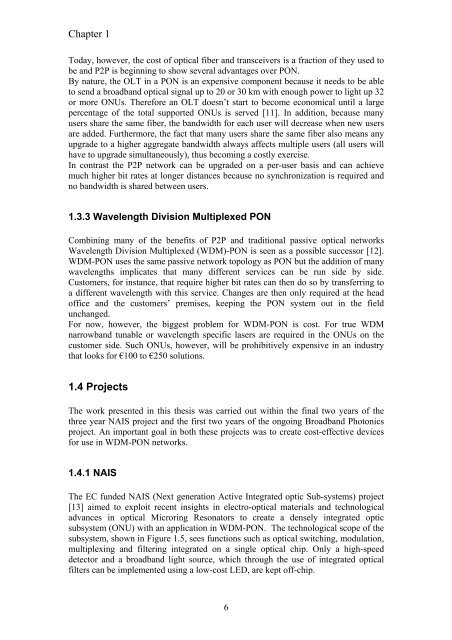Edwin Jan Klein - Universiteit Twente
Edwin Jan Klein - Universiteit Twente
Edwin Jan Klein - Universiteit Twente
You also want an ePaper? Increase the reach of your titles
YUMPU automatically turns print PDFs into web optimized ePapers that Google loves.
Chapter 1<br />
Today, however, the cost of optical fiber and transceivers is a fraction of they used to<br />
be and P2P is beginning to show several advantages over PON.<br />
By nature, the OLT in a PON is an expensive component because it needs to be able<br />
to send a broadband optical signal up to 20 or 30 km with enough power to light up 32<br />
or more ONUs. Therefore an OLT doesn’t start to become economical until a large<br />
percentage of the total supported ONUs is served [11]. In addition, because many<br />
users share the same fiber, the bandwidth for each user will decrease when new users<br />
are added. Furthermore, the fact that many users share the same fiber also means any<br />
upgrade to a higher aggregate bandwidth always affects multiple users (all users will<br />
have to upgrade simultaneously), thus becoming a costly exercise.<br />
In contrast the P2P network can be upgraded on a per-user basis and can achieve<br />
much higher bit rates at longer distances because no synchronization is required and<br />
no bandwidth is shared between users.<br />
1.3.3 Wavelength Division Multiplexed PON<br />
Combining many of the benefits of P2P and traditional passive optical networks<br />
Wavelength Division Multiplexed (WDM)-PON is seen as a possible successor [12].<br />
WDM-PON uses the same passive network topology as PON but the addition of many<br />
wavelengths implicates that many different services can be run side by side.<br />
Customers, for instance, that require higher bit rates can then do so by transferring to<br />
a different wavelength with this service. Changes are then only required at the head<br />
office and the customers’ premises, keeping the PON system out in the field<br />
unchanged.<br />
For now, however, the biggest problem for WDM-PON is cost. For true WDM<br />
narrowband tunable or wavelength specific lasers are required in the ONUs on the<br />
customer side. Such ONUs, however, will be prohibitively expensive in an industry<br />
that looks for €100 to €250 solutions.<br />
1.4 Projects<br />
The work presented in this thesis was carried out within the final two years of the<br />
three year NAIS project and the first two years of the ongoing Broadband Photonics<br />
project. An important goal in both these projects was to create cost-effective devices<br />
for use in WDM-PON networks.<br />
1.4.1 NAIS<br />
The EC funded NAIS (Next generation Active Integrated optic Sub-systems) project<br />
[13] aimed to exploit recent insights in electro-optical materials and technological<br />
advances in optical Microring Resonators to create a densely integrated optic<br />
subsystem (ONU) with an application in WDM-PON. The technological scope of the<br />
subsystem, shown in Figure 1.5, sees functions such as optical switching, modulation,<br />
multiplexing and filtering integrated on a single optical chip. Only a high-speed<br />
detector and a broadband light source, which through the use of integrated optical<br />
filters can be implemented using a low-cost LED, are kept off-chip.<br />
6















